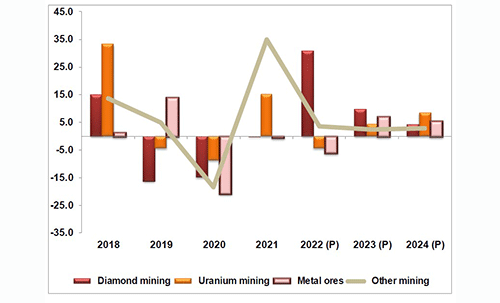The domestic economy is projected to improve in 2022 before moderating in 2023. The latest economic outlook from the Bank of Namibia (BoN) shows that the country’s real GDP growth is estimated to increase to 3.9% in 2022 before moderating slightly to 2.7% in 2023, the same as that registered in 2021.
As such, the central bank’s estimated domestic growth for 2022 represents a 0.7 percentage point upward from the August 2022 Economic Outlook
release. The revision in the 2022 growth is mainly on account of strong growth for diamond mining, based on higher production volumes to date, as well as sustained growth for most industries in secondary and tertiary sectors. Most of the sectors in the secondary and tertiary industries are expected to register positive but low growth rates during 2022 and 2023.
Furthermore, BoN stated that risks to domestic economic growth are predominantly in the form of monetary policy tightening around the world, and high costs of key import items that are likely to persist in the near-term.
“Major central banks around the world are tightening monetary policies at faster rates than initially anticipated, a trend that could lead to a global recession. Furthermore, the ongoing war between Russia and Ukraine is likely to continue, and as a consequence, prices for affected commodities are likely to remain elevated. Other risks include water supply interruptions that continue to affect mining production at the coast, and uncertainty around the effects of climate change on agricultural production, going forward,” the BoN outlook added.
Meanwhile, global economic growth is projected to slow down during 2022 and 2023, following stronger growth in 2021.
“The expected slowdown in global growth during 2022 and 2023 incorporates the effects of high economic costs emanating from the ongoing Russia-Ukraine war through higher commodity prices, particularly for food and fuel, trade disruptions and tighter financial conditions resulting from higher inflation rates in major economies,” the central bank said.
According to the IMF’s World Economic Outlook (WEO) for October 2022, global growth is projected to slow down from 6% registered in 2021 to 3.2% in 2022, and further to 2.7% in 2023. The growth projection for 2022 remained unchanged from the July 2022 WEO update. The IMF, however, downgraded its growth forecast for
2023 by 0.2 percentage points.
Looking at economic activity in Emerging Markets and Developing Economies (EMDEs), BoN expects this to drop in 2022 and 2023.
“Growth in EMDEs is expected to slow down to 3.7% in 2022 and 2023 from an expansion of 6.6% recorded in 2021. The EMDEs’ growth estimate for 2022 was slightly adjusted upwards by 0.1 percentage point, whereas the 2023 estimate was adjusted downwards by 0.2 percentage point from the July 2022 WEO update,” the central bank added.
In addition, sub-Saharan African growth is projected to slow down in 2022 before improving in 2023. GDP growth in the sub-Saharan African region is expected to slow from 4.7% in 2021 to 3.6% in 2022 before improving to 3.7% in 2023. The latest growth projections were revised downwards from the July 2022 WEO update, which reflects the negative impact of elevated food and fuel prices, coupled with sluggish demand for export commodities for most of the countries in the region. Moreover, the weaker growth outlook in sub-Saharan Africa is predominantly attributed to lower trading partner growth, deterioration in terms of trade, and tighter financial and monetary conditions.
Then in terms of risks to global growth, this is expected to be dominated by uncertainties around Covid-19, further implications from geo-political conflicts, volatile commodity prices, and a faster pace of monetary tightening.
“The uncertainty regarding the prolonged war between Russia and Ukraine poses a risk to the global outlook, owing to the global increases in food and fuel prices. Furthermore, supply chain disruptions, along with the more stringent financial conditions, pose additional risks to the global growth outlook.
Other risks to global growth include increased volatility in international commodity prices and the sustained slowdown of growth in China, which would have major global spillovers,” the central bank stated.


